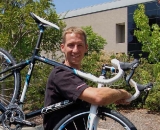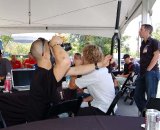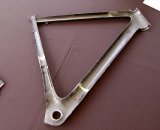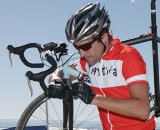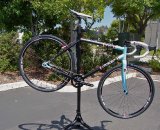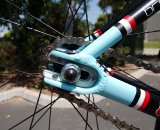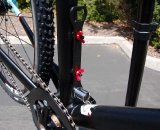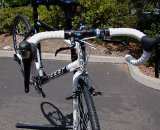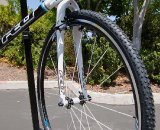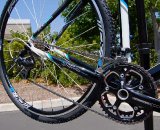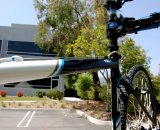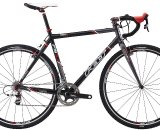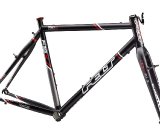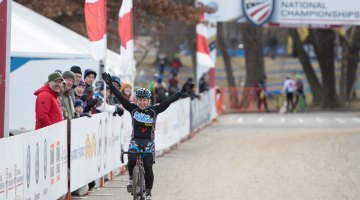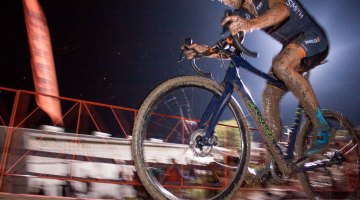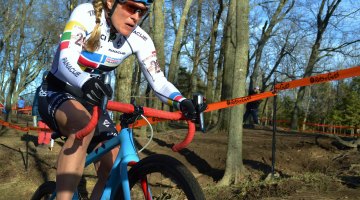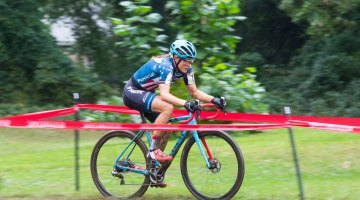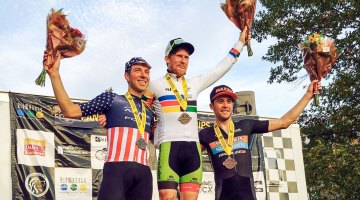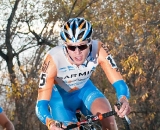
Danny Summerhill piloting his Felt F15X to a top 10 finish at the 2009 Boulder Cup. © Dejan Smaic / sportifimages.com
by David Lawson
Tucked away in a non-descript Orange County industrial park just a few minutes away from the venue of Spooky Cross, SoCal’s largest cyclocross race, lies the world headquarters of Felt Bicycles. The unveiling last week of Felt’s 2011 line of bicycles drew out cycling’s tech illuminati from behind their workstations to poke, prod and photograph the company’s latest offerings.
Although some of my most burning questions were not addressed (e.g. how does Steve Cozza’s mustache perform in the wind tunnel), I did learn about how Felt approaches R&D for its most advanced bikes. Three hours of lectures covering computational fluid dynamics, finite element analysis, new methods for ultra-low void carbon molding, wind tunnel testing and tweaking carbon lay-up schedules revealed a methodology of iterative development that produces fast, light bikes with great riding characteristics. The process is impressive — even more so when one considers that the company has fewer than 60 full-time employees designing and selling 140 models of bicycles.
In addition to Felt’s R&D methodology, I was equally impressed by their design philosophy. Felt strives to create bicycles that are holistic systems rather than just nice frames with components hung on them. The result of tightly integrating components with framesets has led to some nifty design features. For example, the F-series (road bike) frames include holes for internally routing DI2 electronic cables. These holes become bolt-on cable guide mount points when used with mechanical shifting setups. Similar thoughtful integrated design is seen in Felt’s flagship DA time trial/tri bike: the seat post has a rear facing mount point for a DI2 battery, a configuration that is actually more aerodynamic than a naked seat post. The DA also has a revamped fork/headset design that, in order to keep the frontal profile as narrow as possible, pivots around a 9mm steer tube (yes, you read the correctly) seated between 17 mm bearings. But enough about skinny tire bikes, let’s talk about ’cross…
It turns out that the same guys at Felt who design these high-zoot road machines also climb aboard ’cross bikes every fall and rip it up in the local SoCal ’cross series. Thus, Felt’s cyclocross line — now in its eighth year of production — truly consists of ’cross bikes designed by ’cross racers. For 2011, Felt will produce the same three race-ready cyclocross models that it sold in 2010. Felt’s singlespeed model, the Breed, will continue unchanged for 2011. “Why mess with a good thing?” quipped Dave Koesel, Felt’s brand manager responsible for their ’cross line. Similarly, the geared F15X and F75X have received only minor tweaks for 2011, both getting bottom bracket makeovers via the inclusion of a BB30. The result is a taller cross-section chainstay that yields improved mud clearance as well as an overall lighter and better-riding bicycle. In addition, the F15X — the same bike that propelled Danny Summerhill to a U23 national championship in Bend last December — will also be getting an upgrade from the aluminum SRAM S500 crank to the carbon S900 model. Felt’s triumvirate of ’cross models offers something for every price point with the Breed listed at $949, while the F75X and F15X will retail at $1699 and $2799, respectively. The F15X will also be available as a frame kit at $1499.
At the end of the day, after learning the nuances of carbon frame design and looking over the 2011 bikes, I couldn’t leave without asking Dave Koesel the obvious question: “How soon are we going to see a Felt full-carbon cyclocross frame?” I was rewarded with a wink, a big smile, and a “Sorry, no comment.” It was certainly an encouraging (although cryptic) answer — especially if you’re a carbon aficionado. On the other hand, maybe I should have asked about Cozza’s moustache instead.
Photo Gallery












